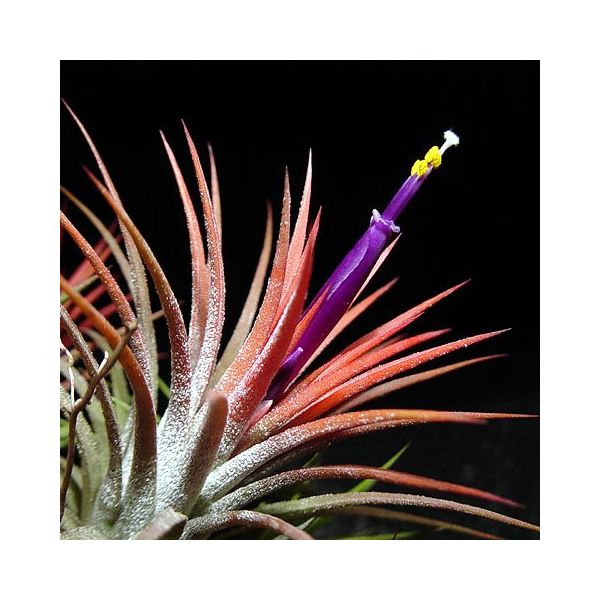Tillandsia Ionantha Seeds (Bromeliad Seeds, Shy Plant Seeds)
Tillandsia Ionantha Seeds (Bromeliad Seeds, Shy Plant Seeds)
Requires minimal care. Perfect for beginners or busy people.

Delivery
All orders shipped with UPS Express.
Always free shipping for orders over US $250.
All orders are shipped with a UPS tracking number.
Returns
Items returned within 14 days of their original shipment date in same as new condition will be eligible for a full refund or store credit.
Refunds will be charged back to the original form of payment used for purchase.
Customer is responsible for shipping charges when making returns and shipping/handling fees of original purchase is non-refundable.
All sale items are final purchases.
Help
Give us a shout if you have any other questions and/or concerns.
Email: contact@domain.com
Phone: +1 (23) 456 789
Availability: In stock
SKU
Tillandsia Ionantha
Tillandsia ionantha belongs to the Bromeliaceae family native to Central America and is found from Mexico to Nicaragua. This epiphyte is well adapted to its rather unique ecological niche, growing attached to the high branches of trees where it receives exposure to the sunlight that the canopy of trees shades from the forest floor below. It is a small stem less plant, often found growing in clumps large enough to encircle a tree branch. Tillandsia ionantha form a bulky rosette, standing like an aloe, 8 to 10 cm in height.
Its leaves are colored from gray to red. They are triangular, tough, superimposed and especially erect. The lower face is scaly and grayish. Before flowering, the end of the central leaves (bracts) turns to a stunning pink. At the time of flowering, the violets flowers with long stamens like two yellow bayonets, appears in the middle of the plant. When grown in bright light the entire plant quickly turns a fiery crimson color, with grape-violet flowers emerging from the center.
The culture of the tillandsia in a vegetative state is rather easy if the humidity of the atmosphere is high. However the flowering of the plant is more difficult to obtain. Moreover, the plant decays slowly and dies a few years after its flowering. The rejections which appear at the base will flower in their turn a few years later. Recover the rejections when the plant mother is desiccated and place them in small pots.
Hardiness zones: 9-11 (-5øC/25øF, 4øC/40øF) in winter. The tillandsia requires a sharp light in summer and sun in winter. Place it close to a window directed at the west in summer and the south in winter. The ideal temperature in summer is 22 to 24 §C. In winter the temperature can be cooler (18 to 16 §C) but it should not go lower than 13 §C. The tillandsia is demanding on the level of moisture. Keep the water content of the air high. If you do not have a humidifier, regularly vaporize the plant with water at room temperature. If you cultivate it in a pot, place it on a wet gravel bed. Eliminate the yellowed leaves, cut the inflorescence after flowering and vaporize the foliage regularly.
This plant absorbs water mainly by its leaves. Regularly vaporize the plant with water at ambient temperature. You can plunge the plant with its support in water at ambient temperature (add a low dose of manure) during one hour, then let drain. If the plant is cultivated in a pot, sprinkle moderately to humidify the substrate, and let drain. Let the substrate dry slightly between watering, but never completely. In winter, when the temperature gets cooler, reduce watering and vaporization to let the soil dry for a short period. The tillandsia does not tolerate mineral salt very well. For the period of growth, fertilize once a month by vaporizing the foliage with a solution of the 20-20-20 diluted by half.
The tillandsia develops few roots. This is why it is often fixed on pieces of wood or plates of bark using wire, with the roots surrounded by foam of sphagnum. Its installation can take place anytime in the year, except during flowering. The tillandsia can also be cultivated out of a pot if the substrate is porous and drains well. In this case, you can use fibers of Osmond, sphagnum moss or sphagnum peat, and pearlite like substrate, and gravel for the bottom of the pot. This plant once out of pot should almost never be repotted.
| Common name | Tillandsia |
|---|---|
| Species | Tillandsia ionantha |
| Germination | All bromeliad seed needs light to germinate. The seeds are sown on the surface of a fine potting mixture. Keep the mixture moist but not sodden. The container can be placed in a plastic bag to conserve moisture. The seed are sprayed regularly but allowed to dry out between watering. For all seed, some sign of germination should be apparent in 2-4 weeks with the development of a small green spot. This is the first seed leaf and is followed by a small root, more tiny leaves and more roots. Germination can take time. Be patient! |
| Price View | Price Range |

